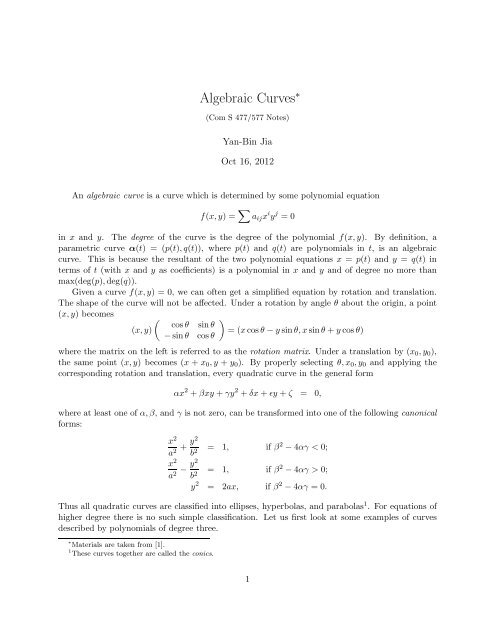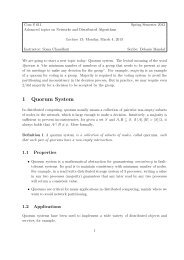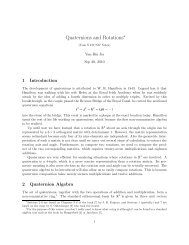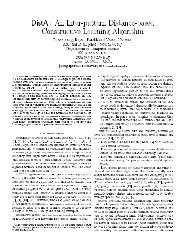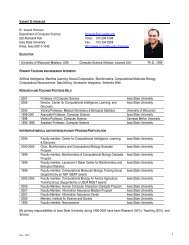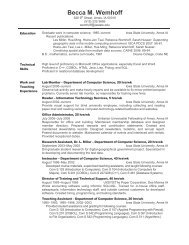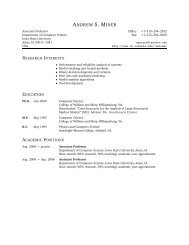Algebraic Curves∗
Algebraic Curves∗
Algebraic Curves∗
You also want an ePaper? Increase the reach of your titles
YUMPU automatically turns print PDFs into web optimized ePapers that Google loves.
<strong>Algebraic</strong> Curves ∗<br />
(Com S 477/577 Notes)<br />
Yan-Bin Jia<br />
Oct 16, 2012<br />
An algebraic curve is a curve which is determined by some polynomial equation<br />
f(x,y) = ∑ a ij x i y j = 0<br />
in x and y. The degree of the curve is the degree of the polynomial f(x,y). By definition, a<br />
parametric curve α(t) = (p(t),q(t)), where p(t) and q(t) are polynomials in t, is an algebraic<br />
curve. This is because the resultant of the two polynomial equations x = p(t) and y = q(t) in<br />
terms of t (with x and y as coefficients) is a polynomial in x and y and of degree no more than<br />
max(deg(p),deg(q)).<br />
Given a curve f(x,y) = 0, we can often get a simplified equation by rotation and translation.<br />
The shape of the curve will not be affected. Under a rotation by angle θ about the origin, a point<br />
(x,y) becomes<br />
( ) cos θ sin θ<br />
(x,y)<br />
= (xcos θ − y sin θ,xsin θ + y cos θ)<br />
− sin θ cos θ<br />
where the matrix on the left is referred to as the rotation matrix. Under a translation by (x 0 ,y 0 ),<br />
the same point (x,y) becomes (x + x 0 ,y + y 0 ). By properly selecting θ,x 0 ,y 0 and applying the<br />
corresponding rotation and translation, every quadratic curve in the general form<br />
αx 2 + βxy + γy 2 + δx + ǫy + ζ = 0,<br />
where at least one of α,β, and γ is not zero, can be transformed into one of the following canonical<br />
forms:<br />
x 2<br />
a 2 + y2<br />
b 2 = 1, if β 2 − 4αγ < 0;<br />
x 2<br />
a 2 − y2<br />
b 2 = 1, if β 2 − 4αγ > 0;<br />
y 2 = 2ax, if β 2 − 4αγ = 0.<br />
Thus all quadratic curves are classified into ellipses, hyperbolas, and parabolas 1 . For equations of<br />
higher degree there is no such simple classification. Let us first look at some examples of curves<br />
described by polynomials of degree three.<br />
∗ Materials are taken from [1].<br />
1 These curves together are called the conics.<br />
1
1 Some <strong>Algebraic</strong> Curves<br />
The semi-cubical parabola (i.e., a cuspidal cubic) is a cubic curve which has two branches at the<br />
origin, but the tangents there to the two branches coincide. The origin is a cusp of the curve, and<br />
the common limiting tangent (i.e., the x-axis) to the two branches at the cusp is called the cuspidal<br />
tangent. See the figure below.<br />
The algebraic equation of the semi-cubical parabola is<br />
The parametric equation is<br />
y 2 = x 3 .<br />
(x,y) = (t 2 ,t 3 )<br />
where t takes on any real value. This is a parameterization in that both x(t) and y(t) are polynomials<br />
in t. To derive this from the algebraic equation, we consider the intersection of the curve with the<br />
line y = tx for each fixed value of t. Substituting y = tx into y 2 − x 3 = 0 gives x 2 (t 2 − x) = 0 .<br />
solving this gives two copies of the point (x,y) = 0, together with x = t 2 , y = tx = t 3 . Therefore<br />
all points satisfying the algebraic equation are given by the parametric equation (x,y) = (t 2 ,t 3 ).<br />
The polar equation is<br />
ρ = sin 2 θ sec 3 θ, − π 2 < θ < π 2 .<br />
This equation is obtained by substituting x = ρcos θ and y = ρsin θ into the algebraic equation.<br />
We obtain ρ 2 (sin 2 θ − ρcos 3 θ) = 0, which gives ρ 2 = 0 and sin 2 θ − ρcos 3 θ = 0. But the second<br />
equation subsumes the first one. From the polar equation we have<br />
r = (ρcos θ,ρsinθ) = (tan 2 θ,tan 3 θ),<br />
and the substitution t = tan θ yields the parametric equation.<br />
The semi-cubical parabola is an isochronous curve; a particle descending the curve under gravity<br />
falls equal vertical distances in an equal time (Huygens 1687). It was the first algebraic curve whose<br />
arc length was calculated (Neile 1659). Before this the arc length had been found only for certain<br />
transcendental curves such as the cycloid and the equi-angular spiral.<br />
2
Some plane curves appear to have several parts. The simplest example of this is the hyperbola,<br />
which has two unbounded parts that do not meet in the plane. We now give an example of a<br />
cubic curve 2 which appears to have two parts, one of which is bounded and the other of which is<br />
unbounded.<br />
The algebraic equation is<br />
A parametric equation of the curve is<br />
y 2 − x 3 + x = 0.<br />
x = t, y = ± √ t(t 2 − 1) −1 ≤ t ≤ 0 or t ≥ 1.<br />
This parameterization by x is given by solving the algebraic equation to give y as a function of x.<br />
We determine where the line x = t meets the curve for each fixed value of t. Substituting x = t<br />
into y 2 − x 3 + x = 0 gives y 2 − t 3 + t = 0. Solving this gives x = t, y = ± √ t(t 2 − 1). This gives<br />
parameterizations of four parts of the curves, one in each of the four quadrants. These parametric<br />
equations are not differentiable at t = 0, ±1.<br />
An algebraic curve can be parametrized in many different ways. An alternative parametric<br />
equation is given by determining where the line y = tx meets the curve for each fixed value of t.<br />
Substituting y = tx into y 2 − x 3 + x = 0 gives x(t 2 x − x 2 + 1) = 0. Solving this gives the origin<br />
(x,y) = 0, the parameterization<br />
r(t) = 1 (<br />
t 2 − √ (<br />
t<br />
2<br />
4 + 4,t t 2 − √ ))<br />
t 4 + 4<br />
of the bounded part of the curve and the parameterization<br />
r(t) = 1 (<br />
t 2 + √ (<br />
t<br />
2<br />
4 + 4,t t 2 + √ ))<br />
t 4 + 4<br />
of the unbounded part. The origin is not covered by the parameterization of the bounded part,<br />
because it corresponds to the value ∞ of the parameter, that is, to the vertical line x = 0. These<br />
two parameterization are differentiable for all values of t.<br />
2 The figure is taken from [1, p. 60].<br />
3
The polar equation of the same curve is<br />
−ρ 2 cos 3 θ + ρsin 2 θ + cos θ = 0.<br />
This is obtained by substituting x = ρcos θ and y = ρsin θ into the algebraic equation. There are<br />
two values of ρ corresponding to each value of θ.<br />
2 Singular Points<br />
A singular point of the algebraic curve f(x,y) = 0 is a point (a,b) on the curve at which<br />
∂f<br />
∂x = ∂f<br />
∂y = 0,<br />
that is at which the gradient ∇f = 0. At a non-singular point, ∇f ≠ 0. To determine singular<br />
points, it is not sufficient to solve ∇f = 0. We must find simultaneous solutions of ∇f = 0 and<br />
f = 0; that is, we must find those ‘singularities of the polynomial’ which also lie on the curve.<br />
Example 1. Find the singular points of the circle f(x, y) = x 2 + y 2 − 1. From ∇f = (2x, 2y) = 0 we<br />
obtain that x = y = 0. But (0, 0) does not lie on the circle, so the circle has no singular points.<br />
For the cuspidal cubic g(x, y) = y 2 −x 3 = 0, we obtain that ∇g = (−3x 2 , 2y) = 0 if and only if x = y = 0.<br />
The only singular point is (0, 0).<br />
3 Parameterization of <strong>Algebraic</strong> Curves<br />
Consider an algebraic curve given by f(x,y) = 0, where f is a polynomial of degree d ≥ 1. One<br />
question is ‘Is it possible to parameterize the curve?’ We now show that algebraic curves can be<br />
parametrized locally near non-singular points. In general, algebraic curves, or parts of them, can<br />
be parametrized either by x or by y, or by both.<br />
A local parameterization of an algebraic curve near a point (a,b) on the curve, is a parameterization<br />
J → R 2 of a piece of the curve including the point (a,b). Usually we assume that the point<br />
(a,b) corresponds to an interior point of the interval J of parameterization.<br />
Theorem 1 (Local Parameterization Theorem) Let f be a polynomial of degree d ≥ 1 satisfying<br />
f(a,b) = 0 and ∂f<br />
∂y<br />
(a,b) ≠ 0. Then there is an interval J = (a − ǫ,a + ǫ) where ǫ > 0, and<br />
a unique smooth function φ : J → R such that φ(a) = b and f(x,φ(x)) = 0 for all x ∈ J. This<br />
solution gives a unique regular smooth local parameterization of the curve in the neighborhood of<br />
the point (a,b) by the x coordinate, that is, r(x) = (x,φ(x)) for all x ∈ (a − ǫ,a + ǫ). Locally, the<br />
curve f(x,y) = 0 is the graph of the function y = φ(x), and<br />
dφ<br />
dx = −f x<br />
f y<br />
, x ∈ J.<br />
Similarly, in the case where ∂f<br />
∂x<br />
(a,b) ≠ 0, there exists a unique regular smooth local parameterization<br />
(ψ(y),y) defined near b and satisfying ψ(b) = a, f(ψ(y),y) = 0, and<br />
dψ<br />
dy = −f y<br />
f x<br />
for y near b. In the neighborhood of (a,b) the curve f(x,y) = 0 is the graph of the function<br />
x = ψ(y).<br />
4
The above theorem is a special case of the implicit function theorem, of which the proof can be<br />
found in texts on analysis.<br />
These smooth local parameterizations of algebraic curves by x or y are regular; for example,<br />
the derivative of (x,φ(x)) is (1,φ ′ (x)) ≠ 0.<br />
Example 2. Consider the circle given by f(x, y) = x 2 + y 2 − 1 = 0. We have f y = 2y ≠ 0 when y ≠ 0.<br />
Thus the theorem tells us there is a local smooth parameterization by x near (a, b) where a 2 + b 2 = 1 and<br />
b ≠ 0. Indeed the parameterization is given by<br />
(x, √ 1 − x 2 )<br />
or by<br />
(x, − √ 1 − x 2 )<br />
, −1 < x < 1<br />
depending on whether b > 0 or b < 0. In this case, for fixed a with −1 < a < 1, there are two values for b,<br />
and local parameterizations are given.<br />
y<br />
( x, 1- x 2 )<br />
top<br />
semi-circle<br />
x<br />
bottom<br />
semi-circle<br />
( x, - 1- x 2 )<br />
Similarly, for a ≠ 0, there is a local parameterization by y near (a, b). Again this is given by<br />
(√ (<br />
1 − y2 , y)<br />
or by − √ )<br />
1 − y 2 , y , −1 < y < 1<br />
depending on whether a > 0 or a < 0.<br />
4 Curvature of <strong>Algebraic</strong> Curves<br />
In general algebraic curves cannot be parametrized in a simple way, that is, by using a simple<br />
formula which gives a parameterization of the whole curve. Therefore the formula for the curvature<br />
of parametric curves cannot be used. However, according to Theorem 1 algebraic curves can be<br />
parametrized locally near a non-singular point, though not in general using a simple formula. We<br />
now use this result to give a parameter-free formula for the curvature of algebraic curves.<br />
We recall that the Hessian matrix of a polynomial f(x,y) is<br />
( )<br />
fxx f<br />
H = xy<br />
.<br />
f xy f yy<br />
Theorem 2 The curvature of the algebraic curve f(x,y) = 0 at a non-singular point (x,y) on the<br />
5
curve is<br />
( )<br />
fy<br />
(f y , −f x )H<br />
−f x<br />
κ = ±<br />
‖∇f‖ 3<br />
= ± f2 yf xx − 2f x f y f xy + f 2 xf yy<br />
(f 2 x + f 2 y) 3 2<br />
= ± f2 y f xx − 2f x f y f xy + fx 2f yy<br />
(fx 2 + ,<br />
f2 y )3 2<br />
where the sign ‘−’ is chosen in case the motion along the curve is in the direction of the vector<br />
(f y , −f x ) and where the sign ‘+’ is chosen in case the motion along the curve is in the direction of<br />
the vector (−f y ,f x ).<br />
Proof By Theorem 1, the algebraic curve can be given a regular local parameterization near a<br />
non-singular point by α(t) = (x(t),y(t)). Differentiating the equation<br />
( )<br />
f x(t),y(t) = 0,<br />
using the chain rule, we obtain<br />
α ′ · (f x ,f y ) = 0.<br />
Therefore α ′ is orthogonal to (f x ,f y ), and we have α ′ = (x ′ ,y ′ ) = λ(f y , −f x ) where λ ≠ 0 is a<br />
function of t. On differentiating once more we obtain<br />
( )<br />
α ′′ · (f x ,f y ) + (x ′ ,y ′ x<br />
′<br />
)H<br />
y ′ = 0.<br />
Therefore we have<br />
x ′ y ′′ − y ′ x ′′ = α ′′ · (−y ′ ,x ′ )<br />
Since ‖α ′ ‖ = |λ| · ‖(f y , −f x )‖, we have that<br />
= λα ′′ · (f x ,f y )<br />
( )<br />
= −λ(x ′ ,y ′ x<br />
′<br />
)H<br />
y ′ ( )<br />
= −λ 3 fy<br />
(f y , −f x )H .<br />
−f x<br />
κ = α′ × α ′′<br />
‖α ′ ‖ 3 = x′ y ′′ − y ′ x ′′<br />
‖α ′ ‖ 3<br />
= ± f2 yf xx − 2f x f y f xy + f 2 xf yy<br />
‖∇f‖ 3 .<br />
Corollary 3 The algebraic curve has a point of inflection at a non-singular point (a,b) if and only<br />
if,<br />
f 2 y f xx − 2f x f y f xy + f 2 x f yy<br />
is zero at (a,b) and changes sign as (x,y) moves through (a,b) along the curve.<br />
6
Thus in order to find all points of inflection of an algebraic curve we first determine the points<br />
where the curvature is zero by finding the simultaneous solutions of the equations<br />
f(x,y) = 0,<br />
f 2 y f xx − 2f x f y f xy + f 2 x f yy = 0,<br />
and then find those solutions which are non-singular points. Next, we determine whether the<br />
curvature changes sign as we move along the curve past the point of zero curvature. If it does, the<br />
point is an inflection. In practice we can check on the change of sign if, for example, the curve can<br />
be parametrized near the point by x, and<br />
f 2 y f xx − 2f x f y f xy + f 2 x f yy<br />
becomes a function of x after substituting from f(x,y) = 0. Such a local parameterization by x<br />
exists by Theorem 1 provided that the tangent at the point is not parallel to the y-axis.<br />
Example 3. Calculate the curvature of the hyperbola<br />
at the point (2, 1).<br />
Let f = x 2 − 3y 2 − 1. We have<br />
Therefore<br />
κ =<br />
x 2 − 3y 2 = 1<br />
f x = 2x,<br />
f y = −6y,<br />
f xx = 2,<br />
f xy = 0,<br />
f yy = −6.<br />
± (−6y)2 · 2 + (2x) 2 · (−6)<br />
(4x 2 + 36y 2 ) 3 2<br />
= ± 9y2 − 3x 2<br />
.<br />
(x 2 + 9y 2 ) 3 2<br />
In particular,<br />
κ(2, 1) = ± 3<br />
( √ 13) 3 .<br />
Example 4. Find the points of inflection of the acnodal cubic<br />
f(x, y) = y 2 + x 2 − x 3 = 0.<br />
We have<br />
f x = 2x − 3x 2 ,<br />
f y = 2y,<br />
f xx = 2 − 6x,<br />
f xy = 0,<br />
f yy = 2.<br />
7
Eliminating y from<br />
we have, on the curve, that<br />
f(x, y) = y 2 + x 2 − x 3<br />
= 0,<br />
f 2 y f xx − 2f x f y f xy + f 2 x f yy = 4y 2 (2 − 6x) + 2(2x − 3x 2 ) 2<br />
= 8y 2 − 24xy 2 + 8x 2 − 24x 3 + 18x 4 ,<br />
f 2 y f xx − 2f x f y f xy + f 2 x f yy = 8x 3 − 6x 4 .<br />
The origin is a singular point. Therefore there are precisely two points of zero curvature. They are<br />
At these points<br />
∇f = (2x − 3x 2 , 2y)<br />
is not parallel to the y-axis, and therefore the curve can be parametrized locally by x. Also<br />
8x 3 − 6x 4 = 6x 3 ( 4<br />
3 − x )<br />
( )<br />
4<br />
3 , ± 4<br />
3 √ .<br />
3<br />
changes sign as we move along the curve past each of the points and therefore the curvature also changes<br />
sign. Thus the two points are points of inflection.<br />
References<br />
[1] J. W. Rutter. Geometry of Curves. Chapman & Hall/CRC, 2000.<br />
8


